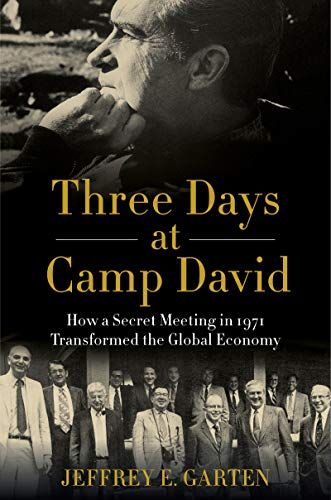Economist Jeffrey E. Garten details the momentous weekend when President Richard Nixon and his advisers upended the global economy and changed history.

Leaving the Gold Standard
Jeffrey E. Garten, former senior adviser to the Nixon, Carter and Clinton administrations, reveals how President Richard Nixon’s decision – made over one tumultuous weekend in 1971 – to end the Bretton Woods fixed-currency system turned out to be a pivotal moment in history.
The postwar monetary arrangement contained the seeds of its own demise. Jeffrey E. Garten
Garten – who is also a prolific author, dean emeritus of the Yale School of Management, and a former managing director at the Blackstone Group and at Lehman Brothers – provides authoritative and nearly novelistic detail about the personalities involved in the clandestine meetings and their motives, which proved both economic and profoundly political. Garten explains why breaking with the gold standard marked a crucial point in US history: It signaled the beginning of the end of America’s role as leader of the free world.
Unsustainable
The 1944 Bretton Woods conference determined that the world’s major currencies would be fixed to the US dollar and allowed to fluctuate only by 1%. Any foreign government or central bank could exchange US dollars for gold at a $35-per-ounce fixed exchange rate. Economists believed this provided a stable and predictable foundation for a then-recovering post-World War II economy.
In Garten’s analysis, this also enabled the United States to dominate the world economy. As other nations regained manufacturing capacity, their exports to the United States grew.
Historian Allen Matusow called the period the ‘death watch for Bretton Woods.Jeffrey E. Garten
America paid dearly for the Vietnam War and President Lyndon Johnson’s social programs, which added US dollars and US dollar-denominated debt into the world economy, causing the dollar to strain against the fixed exchange rate.
Distorted Currency Values
In 1955, the United States held gold covering 1.6 times its theoretical liabilities to other central banks and governments. But by the summer of 1971, it had roughly one-quarter of the gold to match these liabilities. Foreign governments and central banks holding US dollar reserves could see the situation worsening, Garten reports, but they did not want to antagonize the United States by cashing in their dollars for gold.
Uncle Sam had been flooding the world with dollars through the Marshall Plan, through other foreign aid programs, through its financing of US troops and bases abroad, and through the growing foreign investments of US multinational companies. Jeffrey E. Garten
Cumulative domestic inflation and fixed exchange rates made imports more attractive to American consumers; high relative costs and wages made US exports uncompetitive. The growing volume of dollars changing hands decreased central banks’ control of the Bretton Woods system.
Camp David
Nixon summoned Secretary of the Treasury John Connally, Treasury Undersecretary Paul Volcker, head of the Federal Reserve Arthur Burns and economic adviser George Shultz to Camp David, the presidential retreat. During that secret conference over the weekend of August 13 to August 15, 1971, all except one of the participants agreed that the United States should act unilaterally to sever America’s long-standing commitment to the dollar-gold link. Burns alone opposed cutting the link.
Only a few participants knew the specific agenda, but most understood that the meeting would be momentous. Jeffrey E. Garten
On August 15, 1971, giving only a few hours notice to other countries and with more than 46 million people watching, Nixon announced cutting the gold link, imposing a 10% tariff on all imports, and establishing wage and price controls. As a result of what became known as the “Nixon Shock,” Garten clarifies, central banks worldwide would be left holding US dollars of uncertain value.
Economics or Politics?
Connally’s nationalist view held that imposing a tariff meant negotiating from strength. Other countries saw it as hypocritical, because the United States had always espoused free trade.
Politicians and economists had long deployed fiscal and monetary policies to manage inflation and unemployment. These two metrics had risen together, creating stagflation, for which Burns advocated wage and price controls. Many regarded the policy as economically illiterate, and it proved unsuccessful in the medium term. But Nixon could – in the short term – claim he was controlling inflation while stimulating the economy to reduce unemployment. The controls did not stop inflation, Garten explains; instead, they stored it up for later.
The controls were too hard to administer fairly and led to an unwieldy bureaucracy. They gave the administration the illusion that the government could then pursue easy money and lax fiscal policy – which it did. Jeffrey E. Garten
Alongside tax breaks on autos, investment credits, tax incentives for exporters and promised – but never enacted – budget spending cuts, the changes sought to provide something for everyone. Nixon intended to convey the image of a president providing an assertive response to a national crisis.
Most important – and this was key to Connally’s mind-set – the whole was greater than the sum of its parts in political terms, because the package would be seen as big and dramatic, and it would show that Nixon had thought of everything. Jeffrey E. Garten
Garten describes how Nixon spun his answer to US dollar weakness into American forcefulness. The Democratic-controlled Congress supported these policy U-turns, as did the public. But Nixon did not care about inflation or monetary issues; according to Burns, only politics motivated the president.
Floating System
In an increasingly globalized economy, the 1973 oil crisis created currency turmoil. But the United States would not support fixed exchange rates. The Jamaica Accords concluded in Kingston in 1976 formalized the “non-system” of floating currencies that has been in place ever since.
Nixon embarked on a tough, even confrontational approach with America’s closest allies, but having won their undivided attention, Washington pivoted to a policy of decades of international cooperation. Jeffrey E. Garten
In Garten’s summation, Nixon showed good judgment in bringing together an outstanding group of politicians and economists, and he had the good sense to listen to them.
History in Action
What a saga! Garten has held a sufficient number of ring-side seats to the processes of history to understand the eccentric balance of personality, pragmatism and policy that motivates politicians, economists and other high-level decision makers. You don’t need to find economics compelling – or even understand it – to find Garten’s narrative enthralling, suspenseful and fascinating. When he goes too deep into the weeds of policy wonkdom, just skip a page; you won’t lose the thread or lessen the tension.
The decisions made between August 13 and 15, 1971, broke the dam of massive political inertia among the United States and its allies.Jeffrey E. Garten
Garten’s rare combination of government, academic and financial experience allows him to convey the weight of each action he details, its implications and its consequences. Bankers, policy makers, economists, students and professors will benefit from this eye-opening and thoroughly enjoyable read.
Jeffrey E. Garten’s books include From Silk to Silicon, The Mind of the CEO, A Cold Peace, The Big Ten and The Politics of Fortune.










